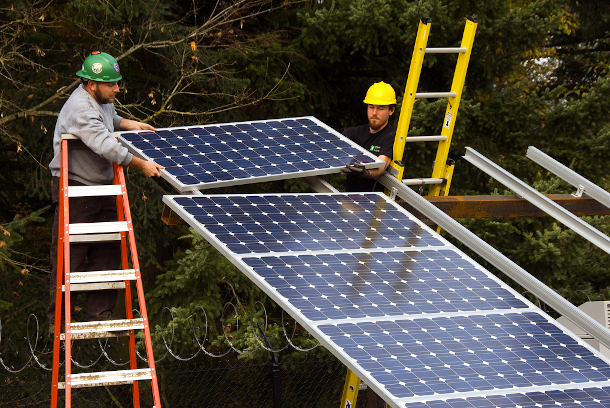Beyond the Headlines
Air Date: Week of January 22, 2021

The wels catfish often grow to a size of 6 feet and a weight of 140lbs, but some scientists speculate that they can grow to over twice that size. (Photo: Craebby Crabbson, Flickr, CC BY-NC 2.0)
In this week's trip beyond the headlines, Host Bobby Bascomb and Environmental Health Weekend News Editor Peter Dykstra take a look at a giant, pigeon-eating European catfish, before turning to the topic of clean energy job loss in the United States.
Transcript
CURWOOD: It’s Living on Earth. I’m Steve Curwood.
BASCOMB: And I’m Bobby Bascomb.
Well, it's time for a trip beyond the headlines with Peter Dykstra. Peter's an editor with Environmental Health News. That's EHN.org and DailyClimate.org. Hey there, Peter, what do you have for us this week?
DYKSTRA: Well, hi, Bobby. As you know, every once in a while we get an invasive species story that sounds like it's straight out of either the cartoons, or the sci-fi world. Well, in this country, we've got the Asian carp, you may have seen video of these 10 or 20 pound fish who breach way clear out of the water, because they go crazy when they hear boat noise. And getting hit by a 10 or 20 pound fish coming out of the water can be memorable. Maybe even more memorable; in Europe, there are catfish species that can weigh up to 600 pounds.
BASCOMB: Oh my goodness.
DYKSTRA: These are enormous catfish, and they've perfected a technique to sort of lay out in the sandbar, half in the water, half out of the water and wait to pounce on an unsuspecting pigeon. Yeah, I'm talking about fish eating birds, not birds eating fish. That's gotta be concerning for the pigeons, although having lived in cities for a good part of my life, I've really got no qualms if an animal wants to eat a few more urban pigeons. But when you have that big an animal come in as an apex predator at the top of the food chain, things can not go well for the local ecosystem.
BASCOMB: Well, what else do you have for us this week?
DYKSTRA: An analysis by the BW Research Partnership, conducted on behalf of several clean energy advocacy groups, links the COVID pandemic to the loss of 400,000 clean energy jobs. That's 12% of the Clean Energy workforce. And those jobs have all been lost since the month of March.

Clean energy jobs have previously been one of the fastest-growing industries in the United Sates, but the COVID-19 pandemic led to many clean energy workers losing their jobs. (Photo: Oregon Department of Transportation, CC BY 2.0)
BASCOMB: Wow, that's a lot of clean energy jobs. I mean, before the COVID outbreak, we were hearing that the renewable energy sector was one of the fastest growing job sectors in the US economy. What happened here?
DYKSTRA: Well, like so many sectors of the US economy, it just crashed to the bottom. Most of those 400,000 jobs, about three quarters of them are in energy efficiency, retrofits and the like, that are generally regarded by a lot of people as optional things and when the economy is on the edge of collapse, you tend not to do the optional things. There are other job losses in wind farms, solar farms, and a lot more. And the BW Research Partnership says that we may not see full recovery in the clean energy sector until the year 2023.
BASCOMB: Hmm, well, like so much of our economy, it's gonna take some time to bounce back. Peter Dykstra is an editor with Environmental Health News. That's EHN.org and DailyClimate.org. We'll talk to you again soon, Peter.
DYKSTRA: Okay, Bobby, thanks a lot. Talk to you soon.
BASCOMB: Thank you. And there's more any stories on the Living on Earth website, LOE.org.
Links
National Geographic | “Enormous Pigeon-Eating Catfish Wreaking Havoc on Europe’s Ecosystems”
Living on Earth wants to hear from you!
Living on Earth
62 Calef Highway, Suite 212
Lee, NH 03861
Telephone: 617-287-4121
E-mail: comments@loe.org
Newsletter [Click here]
Donate to Living on Earth!
Living on Earth is an independent media program and relies entirely on contributions from listeners and institutions supporting public service. Please donate now to preserve an independent environmental voice.
NewsletterLiving on Earth offers a weekly delivery of the show's rundown to your mailbox. Sign up for our newsletter today!
 Sailors For The Sea: Be the change you want to sea.
Sailors For The Sea: Be the change you want to sea.
 The Grantham Foundation for the Protection of the Environment: Committed to protecting and improving the health of the global environment.
The Grantham Foundation for the Protection of the Environment: Committed to protecting and improving the health of the global environment.
 Contribute to Living on Earth and receive, as our gift to you, an archival print of one of Mark Seth Lender's extraordinary wildlife photographs. Follow the link to see Mark's current collection of photographs.
Contribute to Living on Earth and receive, as our gift to you, an archival print of one of Mark Seth Lender's extraordinary wildlife photographs. Follow the link to see Mark's current collection of photographs.
 Buy a signed copy of Mark Seth Lender's book Smeagull the Seagull & support Living on Earth
Buy a signed copy of Mark Seth Lender's book Smeagull the Seagull & support Living on Earth

